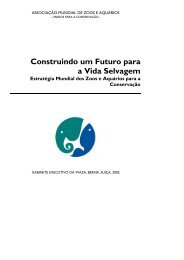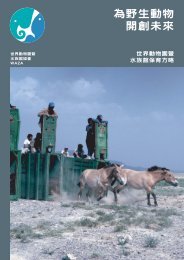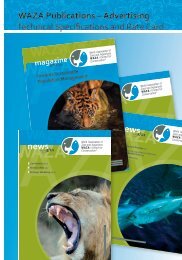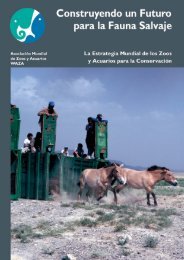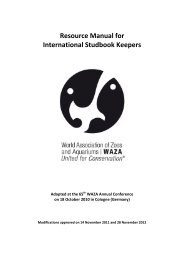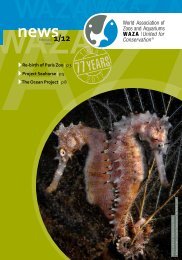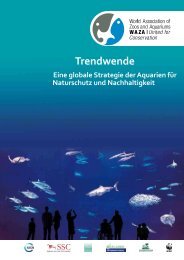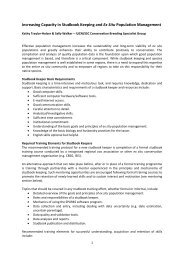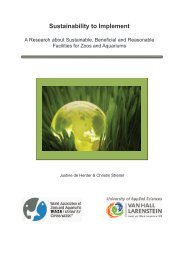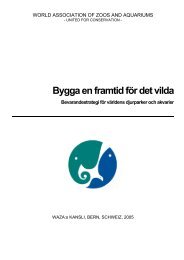Prague - WAZA
Prague - WAZA
Prague - WAZA
Create successful ePaper yourself
Turn your PDF publications into a flip-book with our unique Google optimized e-Paper software.
October 2011 | <strong>Prague</strong> 21<br />
DOC 66.3 rev<br />
Collection<br />
Planning in Zoos<br />
Bert E. M. de Boer<br />
The establishment of cooperative<br />
breeding programmes in the 1980s<br />
was a major breakthrough in the zoo<br />
and aquarium community. By the<br />
mid 1990s the science, organisational<br />
structures and practical requirements<br />
for the long-term management<br />
of captive populations all were<br />
in place, and in the years thereafter<br />
the number of species programmes<br />
steadily increased. Recent evaluations,<br />
however, showed that three<br />
decades of continuous effort resulted<br />
in a disappointingly low number of<br />
sustainable populations in zoo and<br />
aquarium collections. This does not<br />
mean that all hard work has been in<br />
vain. Most probably the current state<br />
of our collections would have been<br />
disastrous if we had not invested so<br />
much energy. What it does mean is<br />
that we urgently need to reconsider<br />
the future of our collections, and the<br />
future of our institutions, as without<br />
sustainable animal collections there<br />
will be no future for zoos and aquariums<br />
themselves.<br />
Meanwhile – during the same three<br />
decades – the world in which we live<br />
has changed enormously. Human<br />
population has increased by two<br />
billions; human consumption and<br />
overexploitation of our planet has<br />
doubled; undisturbed wildlife areas<br />
have drastically decreased in size;<br />
global climate undeniably started<br />
to change; biodiversity loss became<br />
a realistic concern, while the full extent<br />
of the effects of the currently already<br />
greatly diminished ecosystems<br />
still remains to be seen in the near<br />
future. Altogether, it never before has<br />
been so clear how bleak the future of<br />
wildlife in all corners of our planet is!<br />
When we combine these two conclusions<br />
– the deep concern about the<br />
future of zoo and aquarium collections,<br />
and that about the future of<br />
wildlife on Earth – there is only one<br />
possible solution: we need a new<br />
breakthrough, new elan, vision and<br />
work power, leading to what the<br />
first edition of the World Zoo (and<br />
Aquarium) Conservation Strategy<br />
(1993) called “a great mustering of all<br />
available powers to give our Earth’s<br />
biosphere and all its living elements<br />
the best possible chance of survival”.<br />
For zoos and aquariums this means<br />
that they will have to double, triple,<br />
or multiply their efforts to partner<br />
up internally, as well as externally.<br />
Internally, all zoo and aquarium<br />
partnership structures at bilateral, national,<br />
regional and global level need<br />
to be reinforced and intensified. As<br />
a result, the effectiveness of breeding<br />
programmes, collection planning,<br />
and other conservation activities<br />
should substantially increase. Externally,<br />
our most natural (and hopefully<br />
effective) partners are conservation<br />
organisations and authorities. In this<br />
regard partnering should be carefully<br />
planned. <strong>WAZA</strong>’s role is to partner<br />
up with IUCN, WWF, World Bank and<br />
other global organisations, in order<br />
to help influence global conservation<br />
policies and funding. Cooperative zoo<br />
and aquarium species programmes<br />
should link with conservation parks<br />
and their governing bodies to effectuate<br />
interactive population management<br />
and fundraising. Individual<br />
zoos and aquariums should partner<br />
with any relevant local, national or<br />
species-related conservation body to<br />
raise specific funds as well as public<br />
awareness. And there is a whole<br />
range of possible partnerships in<br />
between of these main categories.<br />
In a recent paper in Zoo Biology William<br />
Conway spoke of “Buying time<br />
for wild animals with zoos”; the World<br />
Zoo and Aquarium Conservation<br />
Strategy worded it “Zoos should help<br />
building a time bridge for wildlife”. We<br />
have to admit, however, that time<br />
is running out. Zoos and aquariums<br />
worldwide indeed have a major role<br />
to play, and they have enormous<br />
potentials to help save wildlife on<br />
our planet. But if we do not act very<br />
rapidly to build effective global partnership<br />
networks at all relevant levels,<br />
we better stop using such phrases.



